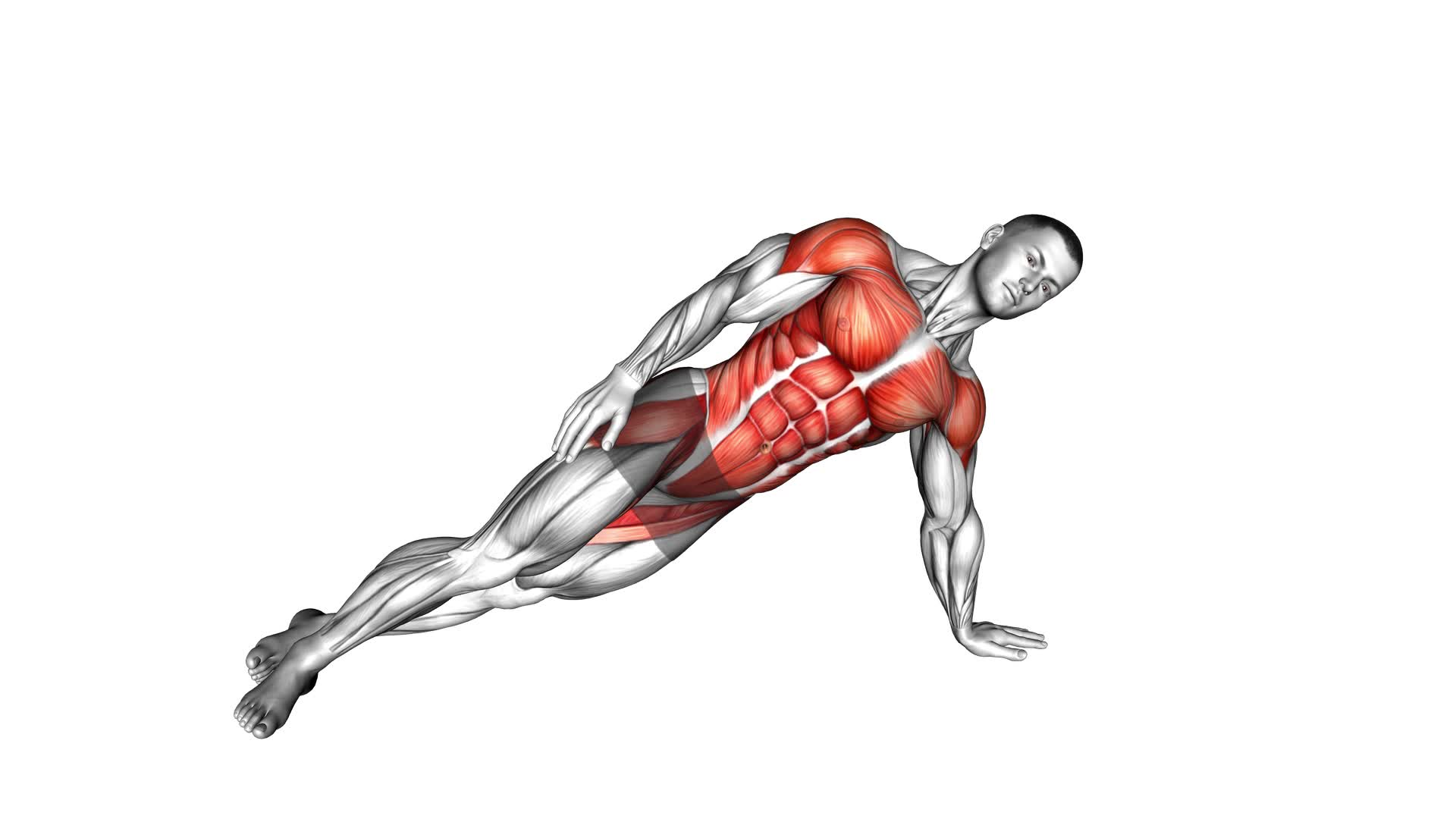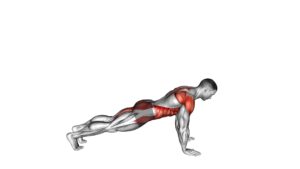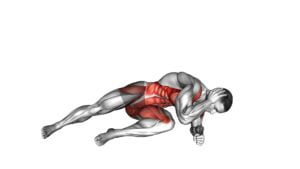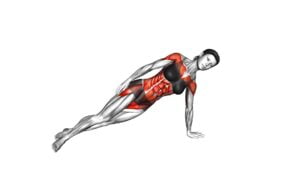Side Plank Pull (male) – Video Exercise Guide & Tips

Get ready to strengthen your core with the Side Plank Pull. This exercise targets your obliques and improves stability.
Watch This Exercise Video
In this video guide, you'll learn the proper form and technique for maximum results. Discover modifications to increase the difficulty and avoid common mistakes.
Incorporate the Side Plank Pull into your routine and level up your fitness game. Let's get started!
Key Takeaways
- The Side Plank Pull is a highly effective exercise for improving core strength and stability.
- It targets various muscles including the obliques, transverse abdominis, glutes, deltoids, and latissimus dorsi.
- Proper form and technique are crucial to ensure maximum engagement of the targeted muscles and to avoid injury.
- Modifications and progressions can be made to increase the difficulty of the exercise and challenge different muscle groups.
Benefits of the Side Plank Pull
Discover the many benefits of the Side Plank Pull for your core strength and stability. This exercise is highly effective in improving your core strength, which is essential for overall stability and balance in your body. The Side Plank Pull targets your obliques, transverse abdominis, and glutes, helping to strengthen and tone these muscles.
One of the key benefits of the Side Plank Pull is its ability to engage multiple muscle groups simultaneously. By performing this exercise, you not only work your core muscles but also activate your shoulders, arms, and back. This makes it a great full-body exercise that can help you build strength and improve your functional fitness.
Another advantage of the Side Plank Pull is its versatility. It offers variations that are suitable for beginners, allowing them to gradually build up their core strength. Beginners can start by performing a modified version of the exercise, such as the knee-supported Side Plank Pull or the Side Plank with a hip dip. These variations reduce the intensity while still targeting the core muscles effectively.
Incorporating the Side Plank Pull into your fitness routine can lead to significant improvements in your core strength and stability. By regularly performing this exercise and gradually progressing to more challenging variations, you can strengthen your core muscles and enhance your overall physical performance.
Proper Form and Technique
To perform the Side Plank Pull correctly, start by positioning yourself in a side plank position. Here's how to execute the exercise with proper form and technique:
- Start by lying on your side, propping yourself up on your forearm with your shoulder directly above your elbow.
- Stack your feet on top of each other and engage your core muscles to lift your hips off the ground, creating a straight line from your head to your feet.
- Extend your top arm straight up towards the ceiling.
- Keeping your body stable, lower your top arm down towards your hip, pulling your shoulder blade back and engaging your back muscles.
- Pause for a moment, then return to the starting position.
- Repeat the movement for the desired number of repetitions, then switch to the other side.
By performing the Side Plank Pull correctly, you can improve stability in your core and target muscle groups such as the obliques, glutes, and shoulder muscles. This exercise helps to build overall strength and improve posture.
To progress the difficulty of the Side Plank Pull, you can increase the number of repetitions, add resistance by using a dumbbell or resistance band, or perform the exercise on an unstable surface such as a Bosu ball. These modifications challenge your stability and engage additional muscles for a more advanced workout.
Modifications for Increased Difficulty
To increase the difficulty of the Side Plank Pull, you can incorporate additional challenges to further engage your muscles and enhance your stability. There are several advanced modifications and progressive variations you can try to take your workout to the next level.
One modification you can make is to add a resistance band. Wrap the band around your waist and anchor it to a sturdy object. This will add resistance and increase the intensity of the exercise.
Another modification is to lift your top leg off the ground while performing the side plank pull. This will engage your core and hip muscles even more.
You can also try performing the exercise on an unstable surface, such as a Bosu ball or a stability disc. This will require more balance and stability, making the exercise more challenging.
Additionally, you can increase the duration of the exercise by holding the side plank position for a longer period of time.
Remember to progress gradually and listen to your body. If an advanced modification feels too challenging, start with a simpler variation and gradually work your way up.
Common Mistakes to Avoid
Now let's explore what're the common mistakes you should avoid when performing the Side Plank Pull exercise. To ensure you maintain proper form and get the most out of this exercise, here are some common mistakes to watch out for:
- Allowing your hips to sag: One of the most common mistakes is letting your hips drop towards the ground. This not only reduces the effectiveness of the exercise but also puts unnecessary strain on your lower back. Make sure to engage your core and keep your body in a straight line from head to toe.
- Pulling with your arm instead of your core: The main focus of the Side Plank Pull is to engage your obliques and core muscles. Avoid relying solely on your arm strength to pull yourself up. Instead, initiate the movement from your core and use your arm as a support.
- Rushing the exercise: It's important to perform the Side Plank Pull with control and precision. Avoid rushing through the movement or using momentum to swing your body up. Take your time and focus on engaging the correct muscles throughout the exercise.
Tips for Maximizing Results
To maximize your results in the Side Plank Pull exercise, it's essential to implement a few key tips. By following these tips, you can effectively maximize muscle growth and optimize your overall workout performance.
Firstly, it's crucial to maintain proper form throughout the exercise. Make sure your body is aligned in a straight line from head to toe, with your core engaged and your hips lifted. This will help target the muscles in your arms, shoulders, and core more effectively, leading to better results.
Secondly, focus on engaging your muscles throughout the entire movement. This means actively squeezing your core and glutes, as well as pulling your shoulder blades down and back. By doing so, you'll create more tension in the muscles, ultimately leading to increased muscle growth.
Additionally, don't forget to breathe properly during the exercise. Take deep breaths in and out, inhaling as you lower your body and exhaling as you pull yourself back up. This will help you maintain control and stability, allowing you to perform the exercise with greater efficiency.
Lastly, be consistent with your training. Incorporate the Side Plank Pull exercise into your regular workout routine and aim to gradually increase the intensity and duration over time. Consistency is key when it comes to maximizing your results and achieving your fitness goals.
Incorporating the Side Plank Pull Into Your Routine
To incorporate the Side Plank Pull into your routine, simply follow these steps:
- Start by lying on your side with your legs extended and stacked on top of each other. Place your forearm on the ground, perpendicular to your body, with your elbow directly under your shoulder.
- Engage your core and lift your hips off the ground, forming a straight line from your head to your heels. This is the starting position.
- Next, reach your free arm up towards the ceiling and then lower it down towards the ground, pulling yourself into a side plank position. Keep your core engaged and your body stable throughout the movement.
- Return to the starting position by reversing the movement, bringing your arm back up towards the ceiling.
- Repeat the exercise for the desired number of repetitions and then switch sides.
Incorporating side plank variations like the Side Plank Pull into your routine is an effective way to strengthen your core. These exercises target not only your abs but also your obliques, lower back, and shoulders.
Frequently Asked Questions
How Long Should I Hold the Side Plank Position Before Performing the Pull?
Before performing the pull in the side plank position, it's important to hold the side plank for a sufficient amount of time. This will help improve your core strength and stability.
The duration of the hold can vary depending on your fitness level and goals. Start with a goal of holding the position for 30 seconds and gradually increase the time as you get stronger.
Remember to engage your core muscles and maintain proper form throughout the exercise.
Can the Side Plank Pull Help With Improving Posture?
The Side Plank Pull can definitely help improve your posture. By incorporating this exercise into your routine, you'll be working on improving your balance and core strength.
This exercise targets the muscles responsible for maintaining proper posture, such as the obliques and back muscles. By strengthening these muscles, you'll be able to maintain a more upright and aligned posture throughout the day.
Is It Necessary to Warm up Before Performing the Side Plank Pull Exercise?
Before performing the side plank pull exercise, warming up is necessary. It helps prepare your muscles and joints for the workout, reducing the risk of injury. Warming up increases blood flow and flexibility, allowing you to perform the exercise more effectively.
Additionally, side plank pull offers several benefits, such as strengthening your core, shoulders, and obliques. It also improves balance and stability.
Can the Side Plank Pull Exercise Be Modified for Individuals With Wrist or Shoulder Injuries?
If you have wrist or shoulder injuries, you may need to modify the side plank pull exercise. To protect your wrist, try using a forearm plank instead of a traditional side plank. This can reduce the strain on your wrists.
For shoulder injuries, you can also modify the exercise by using lighter weights or resistance bands.
Remember to consult with a professional before attempting any modifications to ensure they're safe and effective for you.
How Often Should I Incorporate the Side Plank Pull Into My Workout Routine for Optimal Results?
For optimal results, you should incorporate the side plank pull into your workout routine regularly. Aim to do this exercise at least 2-3 times a week. Each session should last around 10-15 minutes to ensure you're giving your muscles enough time to engage and strengthen.
Remember to maintain proper form and gradually increase the intensity as you progress. Consistency and gradual progression are key to seeing improvements in your strength and stability.
Conclusion
Incorporating the side plank pull into your routine can provide numerous benefits. This exercise is known for strengthening your core, improving balance, and targeting your oblique muscles. By maintaining proper form and avoiding common mistakes, you can maximize your results and increase the difficulty level of this exercise.
Remember to listen to your body and make modifications as needed. It's important to start with proper form and gradually increase the intensity of the exercise over time. This will help prevent injury and ensure that you're getting the most out of your workout.
Consistency and dedication are key when it comes to seeing results from the side plank pull. Make it a regular part of your fitness routine and you'll start to notice improvements in your core strength and balance.
Overall, the side plank pull is a valuable addition to any fitness routine. It offers a variety of benefits and can be modified to suit your individual needs and fitness level. Give it a try and see how it can enhance your workouts.

Author
Years ago, the spark of my life’s passion ignited in my mind the moment I stepped into the local gym for the first time. The inaugural bead of perspiration, the initial endeavor, the very first surge of endorphins, and a sense of pride that washed over me post-workout marked the beginning of my deep-seated interest in strength sports, fitness, and sports nutrition. This very curiosity blossomed rapidly into a profound fascination, propelling me to earn a Master’s degree in Physical Education from the Academy of Physical Education in Krakow, followed by a Sports Manager diploma from the Jagiellonian University. My journey of growth led me to gain more specialized qualifications, such as being a certified personal trainer with a focus on sports dietetics, a lifeguard, and an instructor for wellness and corrective gymnastics. Theoretical knowledge paired seamlessly with practical experience, reinforcing my belief that the transformation of individuals under my guidance was also a reflection of my personal growth. This belief holds true even today. Each day, I strive to push the boundaries and explore new realms. These realms gently elevate me to greater heights. The unique combination of passion for my field and the continuous quest for growth fuels my drive to break new ground.







